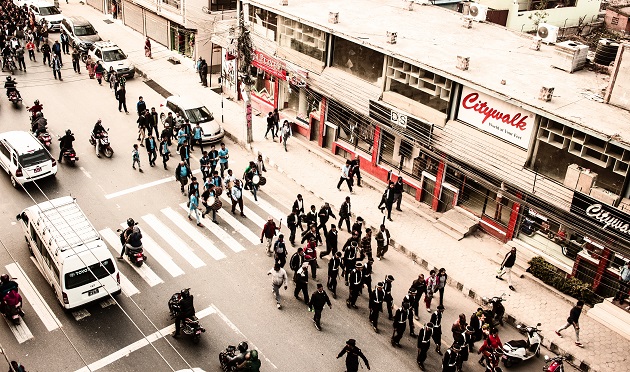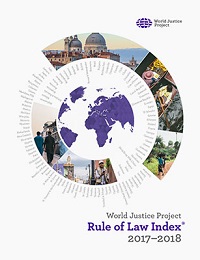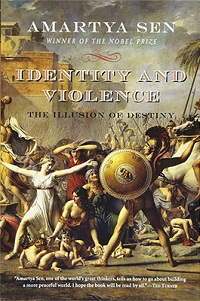Religious identity, nationalism, and violence.
 A protestat in Kathmandu, Nepal. / S. Banet (Unsplash, CC0)
A protestat in Kathmandu, Nepal. / S. Banet (Unsplash, CC0)
Across the region of South Asia, religion is an important component of the identity of a person. In the light of its history of colonialism and its wide diversity of language and culture, religious identities have naturally strengthened there. However, some social and political groups have manipulated them to mobilize support. In the recent past, a growing overlap between violent religious fundamentalism, nationalism, and majoritarianism has led to increased violence and hostility against religious minorities, especially Christians. For instance:
- In Hindu-majority India, Christians are routinely attacked by mobs allegedly outraged by ‘forcible’ religious conversions. Muslims have also suffered violent attacks, including lynching by cow protection vigilantes on the pretext that they either ate beef or were taking cattle for slaughter.
- In Bangladesh, Buddhist and Hindu communities have suffered violent attacks at the hands of mobs claiming allegiance to Islam. The recent killings of bloggers and atheists are also evidence of the increased hostility to non-Muslims.
- In Sri Lanka, Buddhist monks lead the charge against evangelical Christians and Muslims and have lobbied for strict anti-conversion laws.
- In Pakistan, Hindus, Christians, and even minority Muslim sects such as Ahmadis and Shias find themselves on the receiving end of violent attacks and false accusations under the country’s blasphemy law.
The increased violence has resulted in insecurity and loss of life and property. It has also resulted in increased government restrictions on religious life. This is because governments often use the existence of social hostilities to restrict religious life in general through increased regulation of how religious communities can meet, how they receive funds, and even how they practise their religious beliefs. For instance, violence against Christians in India by Hindu nationalists has repeatedly resulted in the government calling for the enactment of anti-conversions laws which will only further restrict the rights of Christians.
FACTORS FUELING RELIGIOUSLY MOTIVATED VIOLENCE
The main factors that fuel religiously motivated violence are a culture of impunity that allows mob violence to go unpunished, propaganda directed against religious minorities, and a failure to forge common identities among citizens:
1. Weak Rule of Law and the Culture of Impunity

The Rule of Law Index 2017 produced by the World Justice Project surveyed 113 countries on 44 indicators such as constraints on government powers, absence of corruption and upholding fundamental rights, civil justice, etc. Most of the South Asia countries ranked in the upper 60s to lower 100s. Nepal was the best in the region, ranked at 58. These poor rankings reflect a deterioration and slowdown in the justice delivery system that fuels a culture of impunity towards violence by mobs and the excesses of the state.
For instance, in India, according to reports collated by the United Christian Forum, over 250 incidents of violence occurred against Christians in 2017; yet in only 23 cases was a First Information Report (FIR) or criminal complaint filed. According to a government statement to Parliament in February 2017, during the last three years, over 278 people have been killed and over 6,500 injured due to communal violence. There were over 2,000 ‘communal incidents’ across the country but few prosecutions and even fewer convictions.
In a 2016 judgement in WP (Civil) 76/2009 with reference to the widespread and horrific communal violence against Christians in 2008, which resulted in close to 100 deaths and displacement of over 50,000 people in the eastern Indian state of Odisha (formerly known as Orissa), the Supreme Court of India observed:
The affidavit filed on behalf of the State on 01.03.2013 discloses that out of 827 registered cases, 512 cases resulted in filing of charge-sheets while in 315 cases final reports were submitted. In other words, in 315 cases either no offence was found to have been made out or the offenders could not be detected. Such a large proportion is quite disturbing. The State could do well in looking into all these 315 cases and see that the offenders are brought to book. Similarly, out of 362 trials which stand completed only 78 have resulted in conviction, which again is a matter of concern.
When combined with low levels of education, corruption and poverty, weak justice delivery systems have proved to be instrumental in creating a culture where violent religious nationalism is able to operate with impunity. Mobs know that they can get away with violence.
2. Majoritarianism and Propaganda against Religious Minorities
Religious nationalism is extremely problematic when the majority religion uses it to create a clear distinction between the majority and the minority:
- We are taught how ‘they’ are different from ‘us’. We learn how ‘their’ aspirations are detrimental to ‘ours’. The walls are quickly erected and become difficult to knock down.
- Soon, stereotypes take hard shape and we become prejudiced. ‘The Muslims are like this’, ‘the Christians are like that’, ‘Pentecostal groups always act like this’, ‘Catholics never do that’, ‘their culture is different’, and so on.

In India, literature and propaganda material, often in the vernacular and circulated though social media, create myths about both Christians and Muslims, the two minority communities being targeted in the country. The myths, repeated often enough, have now gained a semblance of truth and are echoed even by members of the minority communities themselves.
The most common allegation against Christians in India is that they engage in unethical and forcible conversion. According to rumours, Christians give large sums of money and other inducements to convert people. In response, various provinces in India have enacted legislation to ensure that forcible conversion or conversion by inducement is a punishable offence. However, in spite of the enactment of such laws since the late 1960s, there has been only one known conviction under them. Furthermore, India now has very tight laws regulating how foreign funds can enter the country and how they may be used.
Yet, the propaganda against Christians remains strong and fuels a sense of distrust of Christians in India. This is, sadly, the experience of Christians in many parts of the world, especially the southern Asia region. The propaganda lays the foundation for violence and hostility by creating the ‘other’ who is different from us.
3. Failure to Forge Common Identities
Often, religious nationalist groups focus on only one aspect of the identity of a person or a group. Thus, a divide between the communities is created, by highlighting differences rather than similarities. Even language and culture, which should help bind people and help ideas flow, become a point of contention.

In fact, no one has only one identity. We are composite beings enjoying a wide variety of interests. Nobel Laureate and noted author, Amartya Sen, writes in his book, Identity and Violence: The Illusion of Destiny:
In our normal lives, we see ourselves as members of a variety of groups—we belong to all of them. A person’s citizenship, residence, geographic origin, gender, class, politics, profession, employment, food habits, sports interests, taste in music, social commitments, etc., make us members of a variety of groups. Each of these collectivities, to all of which this person simultaneously belongs, gives her a particular identity. None of them can be taken to be the person’s only identity or singular membership category.
Religious nationalist groups tend to reduce our identities simply to religious identities, thereby isolating minorities and successfully targeting them.
HOW SHOULD WE RESPOND?
How should Christians act in the face of this growing violence and hostility? Based on the experience here in India, I would like to offer some suggestions to tackle these 3 factors fueling them:
1. Work towards strengthening the Rule of Law
a. Legal Literacy: The church and other civil society groups should commit to strengthening the rule of law by helping communities better understand legal processes and basic human rights frameworks. Communities can be made more resilient in the face of violent religious extremism as they understand how to access justice to remedy violations of their human rights by both state and non-state actors.
b. Litigation Assistance: Legal systems are slow and complex; and victims often require assistance to navigate them. Cases frequently are not followed up and taken to their logical end in the courts because victims and witness are fearful, vulnerable, and alone. Christians would do well to stand alongside these victims to enable them to follow through their cases through providing legal assistance to the victims.
c. Advocacy for policy changes: Christians must continue to create opportunities for religious minorities and other vulnerable communities to participate in advocacy for policy changes. Better protection of fundamental rights, greater separation of the powers between the various state institutions, and increased transparency in all state institutions are crucial steps towards strengthening the rule of law.
2. Respond to the Propaganda
a. It is imperative for Christians and civil society to confront the lies with the truth told in a winsome manner. One way to do this is to create opportunities for people to share their own faith journeys.
b. Opportunities need to be created in schools and colleges to help children and younger people understand the composite culture of a region. No one religious community can lay claim to the culture of a nation; this is especially true in South Asia.
c. Christians must also, where appropriate, initiate legal action against agencies or individuals who incite violence against religious minorities, by filing complaints with the police.
3. Forge Common Identities
To build common identities, churches must create opportunities for the body of Christ to work on shared joint events with the public at large on issues that concern the greater common good. Far too often, divisive politics drive vulnerable groups into silos.
Christians in South Asia, as minorities, must resist that temptation and rather embrace their larger shared identities to forge new relationships. The Lausanne Covenant offers an important reminder to each of us that, ‘The church is the community of God’s people rather than an institution, and must not be identified with any particular culture, social or political system, or human ideology.’
CONCLUSION
In response to the growing overlap between religious and nationalistic identities and the resultant violence against religious minorities, the diversity within one body, and the love and respect for different members of it that the global church represents is a unique and important model for a hurting world. It is imperative that Christians continue to live this out. Christians must work towards strengthening the justice delivery system and building deep and meaningful relationships in our neighbourhoods and wider society and with those who are most vulnerable.
Tehmina Arora is a human rights lawyer practicing in Delhi. She serves as Senior Counsel, South Asia, for ADF International and Senior Fellow, South and Southeast Asia Action Team, Religious Freedom Institute.
This article originally appeared in the May 2018 issue of the Lausanne Global Analysis and is published here with permission as part of the LGA Media Partnership. Learn more about this flagship publication from the Lausanne Movement at www.lausanne.org/lga.
Endnotes
Editor’s Note: See article by Kamal Weekarkoon, entitled ‘Christianity in Sri Lanka: How we can learn from and support the church there,’ in March 2014 issue of Lausanne Global Analysis https://www.lausanne.org/content/lga/2014-03/christianity-in-sri-lanka-how-we-can-learn-from-and-support-the-church-there
Editor’s Note: See article by Tehmina Arora entitled, ‘The Spread of Anti-Conversion Laws from India: A threat to the religious freedom of minorities,’ in May 2016 issue of Lausanne Global Analysis https://www.lausanne.org/content/lga/2016-05/anti-conversion-laws-india
Editor’s Note: See article by Thomas Harvey, entitled ‘The State of Religious Persecution: The global rise of secular and religious restriction and their impact on missions,’ in March 2016 issue of Lausanne Global Analysis https://www.lausanne.org/content/lga/2016-03/state-and-religious-persecution
Amartya Sen, Identity and Violence: The Illusion of Destiny (UK: Penguin Random House, 2006).

Las opiniones vertidas por nuestros colaboradores se realizan a nivel personal, pudiendo coincidir o no con la postura de la dirección de Protestante Digital.
Si quieres comentar o